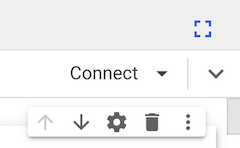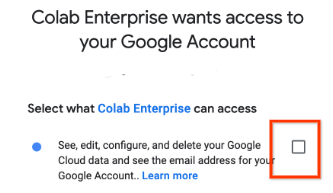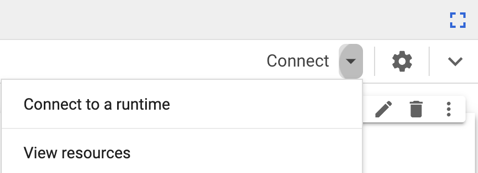Conectarse a un entorno de ejecución
En esta página se explica cómo conectarse a un entorno de ejecución en Colab Enterprise.
Para ejecutar código en tu cuaderno, debes conectarte a un entorno de ejecución. Un tiempo de ejecución es un recurso de computación que ejecuta tu código.
Antes de empezar
- Sign in to your Google Cloud account. If you're new to Google Cloud, create an account to evaluate how our products perform in real-world scenarios. New customers also get $300 in free credits to run, test, and deploy workloads.
-
In the Google Cloud console, on the project selector page, select or create a Google Cloud project.
Roles required to select or create a project
- Select a project: Selecting a project doesn't require a specific IAM role—you can select any project that you've been granted a role on.
-
Create a project: To create a project, you need the Project Creator
(
roles/resourcemanager.projectCreator), which contains theresourcemanager.projects.createpermission. Learn how to grant roles.
-
Verify that billing is enabled for your Google Cloud project.
-
Enable the Vertex AI, Dataform, and Compute Engine APIs.
Roles required to enable APIs
To enable APIs, you need the Service Usage Admin IAM role (
roles/serviceusage.serviceUsageAdmin), which contains theserviceusage.services.enablepermission. Learn how to grant roles. -
In the Google Cloud console, on the project selector page, select or create a Google Cloud project.
Roles required to select or create a project
- Select a project: Selecting a project doesn't require a specific IAM role—you can select any project that you've been granted a role on.
-
Create a project: To create a project, you need the Project Creator
(
roles/resourcemanager.projectCreator), which contains theresourcemanager.projects.createpermission. Learn how to grant roles.
-
Verify that billing is enabled for your Google Cloud project.
-
Enable the Vertex AI, Dataform, and Compute Engine APIs.
Roles required to enable APIs
To enable APIs, you need the Service Usage Admin IAM role (
roles/serviceusage.serviceUsageAdmin), which contains theserviceusage.services.enablepermission. Learn how to grant roles. - Usar el tiempo de ejecución predeterminado
- Conectarse a un entorno de ejecución
- Crear un tiempo de ejecución
-
En la consola, ve a la página Mis cuadernos de Colab Enterprise. Google Cloud
-
En el menú Región, selecciona la región que contiene tu cuaderno.
-
Haz clic en el cuaderno que quieras abrir. Si aún no has creado ningún cuaderno, crea uno.
-
En tu cuaderno, haz clic en Conectar.

-
Si es la primera vez que te conectas a un tiempo de ejecución con las credenciales de usuario final habilitadas, aparecerá el cuadro de diálogo Iniciar sesión.
Para conceder acceso a Colab Enterprise a tus credenciales de usuario, sigue estos pasos:
-
En el cuadro de diálogo Iniciar sesión, haz clic en tu cuenta de usuario.
-
Selecciona Ver, editar, configurar y eliminar tus datos de Google Cloud ... para conceder acceso a Colab Enterprise a tus credenciales de usuario.

-
Haz clic en Continuar.
-
-
En la consola, ve a la página Mis cuadernos de Colab Enterprise. Google Cloud
-
En el menú Región, selecciona la región que contiene tu cuaderno.
-
Haz clic en el cuaderno que quieras abrir. Si aún no has creado ningún cuaderno, crea uno.
-
En tu cuaderno, haz clic en la flecha del desplegable Opciones de conexión adicionales y, a continuación, selecciona Conectar con un tiempo de ejecución.

Se abrirá el cuadro de diálogo Conectar con el tiempo de ejecución de Vertex AI.
-
En Seleccionar un tiempo de ejecución, selecciona Conectar a un tiempo de ejecución.
-
En Seleccionar una opción de tiempo de ejecución, selecciona el tiempo de ejecución al que quieras conectarte. Si no hay ningún tiempo de ejecución en la lista, crea uno o conéctate al tiempo de ejecución predeterminado.
-
Haz clic en Conectar.
-
Si tu tiempo de ejecución tiene habilitadas las credenciales de usuario final y es la primera vez que te conectas a un tiempo de ejecución con las credenciales de usuario final habilitadas, aparecerá un cuadro de diálogo Iniciar sesión.
Para conceder acceso a Colab Enterprise a tus credenciales de usuario, sigue estos pasos:
-
En el cuadro de diálogo Iniciar sesión, haz clic en tu cuenta de usuario.
-
Selecciona Ver, editar, configurar y eliminar tus datos de Google Cloud ... para conceder acceso a Colab Enterprise a tus credenciales de usuario.

-
Haz clic en Continuar.
-
-
En la consola, ve a la página Mis cuadernos de Colab Enterprise. Google Cloud
-
En el menú Región, selecciona la región que contiene tu cuaderno.
-
Haz clic en el cuaderno que quieras abrir. Si aún no has creado ningún cuaderno, crea uno.
-
En tu cuaderno, haz clic en la flecha del desplegable Opciones de conexión adicionales y, a continuación, selecciona Conectar con un tiempo de ejecución.

Se abrirá el cuadro de diálogo Conectar con el tiempo de ejecución de Vertex AI.
-
En Seleccionar un tiempo de ejecución, selecciona Crear un tiempo de ejecución.
-
En el menú Plantilla de tiempo de ejecución, selecciona una plantilla de tiempo de ejecución. Si no hay ninguna plantilla de tiempo de ejecución en la lista, crea una.
-
En el campo Nombre de tiempo de ejecución, introduce un nombre para tu tiempo de ejecución.
-
Haz clic en Conectar.
-
Si la plantilla de tiempo de ejecución que has seleccionado tiene habilitadas las credenciales de usuario final y es la primera vez que te conectas a un tiempo de ejecución con las credenciales de usuario final habilitadas, aparecerá un cuadro de diálogo Iniciar sesión.
Para conceder acceso a Colab Enterprise a tus credenciales de usuario, sigue estos pasos:
-
En el cuadro de diálogo Iniciar sesión, haz clic en tu cuenta de usuario.
-
Selecciona Ver, editar, configurar y eliminar tus datos de Google Cloud ... para conceder acceso a Colab Enterprise a tus credenciales de usuario.

-
Haz clic en Continuar.
-
- Crea un tiempo de ejecución en otra región.
- Crea una plantilla de tiempo de ejecución con una configuración de tipo de máquina diferente y, a continuación, crea un tiempo de ejecución basado en la nueva plantilla.
- Consulta más información sobre los runtimes y las plantillas de runtime.
- Crea una plantilla de tiempo de ejecución.
- Para encontrar un cuaderno que te ayude a poner en marcha tu proyecto rápidamente, consulta la galería de cuadernos.
Conectarse mediante diferentes métodos
En esta página se explica cómo conectarse a un tiempo de ejecución mediante los siguientes métodos:
Usar el tiempo de ejecución predeterminado
En esta sección se describe cómo conectarse al tiempo de ejecución predeterminado.
Roles obligatorios
Para obtener los permisos que necesitas para conectarte al entorno de ejecución predeterminado de un cuaderno de Colab Enterprise, pide a tu administrador que te conceda el rol de gestión de identidades y accesos de usuario de Colab Enterprise (roles/aiplatform.colabEnterpriseUser) en el proyecto.
Para obtener más información sobre cómo conceder roles, consulta el artículo Gestionar el acceso a proyectos, carpetas y organizaciones.
También puedes conseguir los permisos necesarios a través de roles personalizados u otros roles predefinidos.
Conectarse al entorno de ejecución predeterminado
Cuando ejecutas código en un cuaderno por primera vez, Colab Enterprise se conecta automáticamente al entorno de ejecución predeterminado, a menos que especifiques otro entorno de ejecución.
Para conectarte al entorno de ejecución predeterminado sin ejecutar código, haz lo siguiente:
Colab Enterprise se conecta al entorno de ejecución predeterminado. Si el entorno de ejecución predeterminado no se está ejecutando, Colab Enterprise lo inicia y, a continuación, se conecta a él.
Conectarse a un entorno de ejecución
En esta sección se describe cómo conectarse a un tiempo de ejecución con el cuadro de diálogo Conectar con el tiempo de ejecución de Vertex AI.
Roles obligatorios
Para obtener los permisos que necesitas para conectarte a un entorno de ejecución en un cuaderno de Colab Enterprise, pide a tu administrador que te conceda el rol de gestión de identidades y accesos de usuario de Colab Enterprise (roles/aiplatform.colabEnterpriseUser) en el proyecto.
Para obtener más información sobre cómo conceder roles, consulta el artículo Gestionar el acceso a proyectos, carpetas y organizaciones.
También puedes conseguir los permisos necesarios a través de roles personalizados u otros roles predefinidos.
Conectarse al entorno de ejecución
Para conectarte a un tiempo de ejecución, sigue estos pasos:Colab Enterprise se conecta al entorno de ejecución. Si el entorno de ejecución no está en funcionamiento, Colab Enterprise lo inicia y, a continuación, se conecta a él.
Crear un tiempo de ejecución
En esta sección se describe cómo crear un tiempo de ejecución y conectarse a él mediante el cuadro de diálogo Conectar con el tiempo de ejecución de Vertex AI. También puedes crear un entorno de ejecución desde la pestaña Entornos de ejecución.
Roles obligatorios
Para obtener los permisos que necesitas para crear un tiempo de ejecución en Colab Enterprise,
pídele a tu administrador que te conceda el rol de gestión de identidades y accesos
Administrador de Colab Enterprise (roles/aiplatform.colabEnterpriseAdmin) en el proyecto.
Para obtener más información sobre cómo conceder roles, consulta el artículo Gestionar el acceso a proyectos, carpetas y organizaciones.
También puedes conseguir los permisos necesarios a través de roles personalizados u otros roles predefinidos.
Crear un tiempo de ejecución y conectarse a él
Para crear un tiempo de ejecución y conectarte a él mediante el cuadro de diálogo Conectar con el tiempo de ejecución de Vertex AI, sigue estos pasos:Colab Enterprise inicia el entorno de ejecución predeterminado y, a continuación, se conecta a él.
Cambiar a un entorno de ejecución predeterminado con GPUs
Si tu administrador ha habilitado los entornos de ejecución predeterminados con GPU o si tu cuenta de usuario tiene el permiso aiplatform.notebookRuntimeTemplates.create, puedes cambiar a un entorno de ejecución que tenga GPUs después de conectarte al entorno de ejecución predeterminado.
En tu cuaderno, haz clic en Cambiar a GPU.
Para saber cómo habilitar los tiempos de ejecución predeterminados con GPUs, consulta Habilitar tiempos de ejecución predeterminados con GPUs.
Gestión del tiempo de ejecución
De forma predeterminada, cuando creas un tiempo de ejecución, tienes automáticamente los permisos necesarios para eliminar (aiplatform.googleapis.com/notebookRuntimes.delete) e iniciar (aiplatform.googleapis.com/notebookRuntimes.start) ese tiempo de ejecución.
Para saber cómo gestionar tu tiempo de ejecución, incluido cómo eliminarlo, iniciarlo o desconectarte de él, consulta Gestionar tiempos de ejecución.
Solucionar problemas
En esta sección se explica cómo resolver problemas de conexión con los tiempos de ejecución en Colab Enterprise.
No se puede conectar a un tiempo de ejecución
Este problema se produce por varios motivos. Consulta también No se puede conectar a un tiempo de ejecución predeterminado. Las causas más habituales son las siguientes:
El navegador bloquea las cookies de terceros
El navegador que estás usando está bloqueando una cookie de terceros que Colab Enterprise usa para establecer una conexión HTTPS con el tiempo de ejecución.
Para solucionar este problema, configure los ajustes de su navegador para que permita la cookie de terceros DATALAB_TUNNEL_TOKEN del dominio *.aiplatform-notebook.googleusercontent.com.
La red bloquea el tráfico saliente a los dominios de los cuadernos
Las reglas de cortafuegos de tu red bloquean el tráfico saliente a *.aiplatform-notebook.cloud.google.com o *aiplatform.googleapis.com.
Para resolver este problema, configure las reglas del cortafuegos de su red para permitir el tráfico saliente a *.aiplatform-notebook.cloud.google.com
y *aiplatform.googleapis.com.
No se puede conectar a un tiempo de ejecución predeterminado
El siguiente error se produce cuando intentas conectarte a un tiempo de ejecución predeterminado si no hay ninguna plantilla de tiempo de ejecución predeterminado.
Failed to connect to runtime
Cuando te conectas a un tiempo de ejecución predeterminado que aún no se ha creado, Colab Enterprise primero crea una plantilla de tiempo de ejecución predeterminada y, a continuación, usa esa plantilla para generar el tiempo de ejecución predeterminado. Sin embargo, si no tienes los permisos necesarios para crear una plantilla de tiempo de ejecución, Colab Enterprise no podrá crear la plantilla de tiempo de ejecución predeterminada ni el tiempo de ejecución predeterminado.
Para solucionar este problema, pide a tu administrador que te asigne un rol que incluya el permiso aiplatform.notebookRuntimeTemplates.create.
El cuaderno tarda en conectarse al tiempo de ejecución
Unos minutos después de iniciar una conexión con un tiempo de ejecución, el mensaje Connecting sigue apareciendo en la esquina superior derecha del cuaderno y Colab Enterprise aún no se ha conectado al tiempo de ejecución.
Para solucionar este problema, espera unos minutos más. Colab Enterprise sigue conectándose a un entorno de ejecución. Conectarse a un tiempo de ejecución que aún no se está ejecutando puede tardar unos minutos, ya que Vertex AI asigna una nueva instancia de máquina virtual (VM).
No se puede crear un tiempo de ejecución
Este problema se produce cuando no puedes crear un tiempo de ejecución. Consulta también No se puede crear un tiempo de ejecución predeterminado. Las causas más habituales son las siguientes:
Recursos no disponibles
Se produce el siguiente error al intentar crear un tiempo de ejecución.
No available zone found for runtime RUNTIME_ID for machine type MACHINE_TYPE with accelerator type: ACCELERATOR. Please try again later.
Este error se produce si no hay recursos disponibles para la configuración del tipo de máquina en la región de tu cuaderno.
Para solucionar este problema, prueba una de las siguientes opciones:
El tiempo de ejecución predeterminado ya existe
Se produce el siguiente error al intentar crear un tiempo de ejecución a partir de la plantilla de tiempo de ejecución predeterminada cuando el tiempo de ejecución predeterminado ya existe.
Failed to create runtime One click runtime already exists.
Si intentas crear un tiempo de ejecución a partir de una plantilla de tiempo de ejecución predeterminada, Colab Enterprise intentará crear un tiempo de ejecución predeterminado. Solo puede haber un tiempo de ejecución predeterminado por usuario, proyecto y región. Si el entorno de ejecución predeterminado ya existe, Colab Enterprise no podrá crear otro.
Para solucionar este problema, conéctate al tiempo de ejecución predeterminado o crea un tiempo de ejecución a partir de una plantilla de tiempo de ejecución no predeterminada.
No se puede crear un tiempo de ejecución predeterminado
Cuando Colab Enterprise crea un tiempo de ejecución predeterminado, primero crea una plantilla de tiempo de ejecución predeterminada que usa para generar el tiempo de ejecución predeterminado. Si intentas crear un entorno de ejecución predeterminado sin los permisos necesarios para crear una plantilla de entorno de ejecución, Colab Enterprise no podrá crear el entorno de ejecución predeterminado.
Para solucionar este problema, pide a tu administrador que te asigne un rol que incluya el permiso aiplatform.notebookRuntimeTemplates.create.

